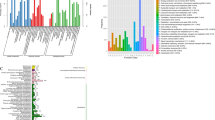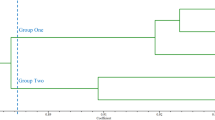Abstract
Simple-sequence repeat (SSR) markers are a common choice for assaying genetic diversity and genetic mapping due to their highly polymorphic and co-dominant nature. In this paper, we developed SSR markers derived from expressed sequence tags (EST-SSRs) based on transcriptome sequences in Lilium regale. In total, 59,046 UniGene sequences (approximately 27.37 Mb) were evaluated, where 1,716 SSR sites in the 1,606 UniGene sequences were identified by data mining. Of these SSRs, the trinucleotide repeats were the most common repeat types (631, 36.8 %), followed by hexa- (23.7 %), di- (23.4 %), penta- (11.5 %), tetra- (3.3 %), hepta- (0.9 %), deca- (0.3 %), and octanucleotide repeats (0.1 %). TC/GA and CCG/CGG predominated in dimeric and trimeric repeat motifs, respectively. In total, 1,072 primer pairs were designed, of which 494 were amplified to yield the expected PCR products in L. regale. The polymorphism and transferability study was performed in six species endemic to China and ten cultivars derived from intraspecific and interspecific hybridization. Of the 494 primer pairs, 172 exhibited clear polymorphisms with stable cross-species amplifications in the 16 individuals, which contained 537 alleles for the 181 loci. The polymorphism information content values for the 172 primers ranged from 0.111 to 0.830, with an average value of 0.493. The phylogenetic dendrogram derived from the amplification profiles of the 172 polymorphic primers was congruent with the genetic background of the hybrids and the species. In addition, the putative functions of the 109 UniGenes containing the 118 polymorphic and transferable EST-SSRs were identified. Thus, the informative EST-SSR markers will be very useful in subsequent Lilium genetic improvement projects.

Similar content being viewed by others
References
Aggarwal RK, Hendre PS, Varshney RK, Bhat PR, Krishnakumar V, Singh L (2007) Identification, characterization and utilization of EST-derived genic microsatellite markers for genome analyses of coffee and related species. Theor Appl Genet 114:359–372
Asano Y (1989) Lilium L. In: Tsukumoto Y (ed) The grand dictionary of horticulture, vol 5. Sykakukum, Tokyo, pp 198–209 (in Japanese)
Baisakh N, Subudhi PK, Arunuganathan K, Parco AP, Harrison SA, Knott CA, Materne MD (2009) Development and interspecific transferability of genic microsatellite markers in Spartina spp. with different genome size. Aquat Bot 91:262–266
Dellaporta SL, Wood J, Hicks JB (1983) A plant DNA minipreparation: version II. Plant Mol Biol 4:19–21
Ellis JR, Burke JM (2007) EST-SSRs as a resource for population genetics analysis. Heredity 99:125–132
Gao YD, Hohenegger M, Harris AJ, Zhou SD, He XJ, Wan J (2012a) A new species in the genus Nomocharis Franchet (Liliaceae): evidence that brings the genus Nomocharis into Lilium. Plant Syst Evol 298:69–85
Gao YD, Zhou SD, He XJ, Wan J (2012b) Chromosome diversity and evolution in tribe Lilieae (Liliaceae) with emphasis on Chinese species. J Plant Res 125:55–69
Hayashi K, Kawano S (2000) Molecular systematics of Lilium and allied genera (Liliaceae): phylogenetic relationships among Lilium and related genera based on the rbcL and matK gene sequence data. Plant Spec Biol 15:73–93
Horning ME, Maloney SC, Webster MS (2003) Isolation and characterization of variable microsatellite loci in Lilum philadelphicum (Liliaeae). Mol Ecol Notes 3:412–413
Huang YF, Yang MX, Zhang H, Zhuang XY, Wu XH, Xie W (2009) Genetic diversity and genetic structure analysis of the natural population of Lilium brownii from Guangdong, China. Biochem Genet 47:503–510
Jansen RC (1996) A general Monte Carlo method for mapping multiple quantitative trait loci. Genetics 142:305–311
Jia XP, Shi YS, Song YC, Wang GY, Wang TY, Li Y (2007) Development of EST-SSR in foxtail millet (Setaria italica). Genet Resour Crop Evol 54:233–236
Kalia RK, Rai MK, Kalia S, Singh R, Dhawan AK (2011) Microsatellite markers: an overview of the recent progress in plants. Euphytica 177:309–334
Kumpatla SP, Mukhopadhyay S (2005) Mining and survey of simple sequence repeats in expressed sequence tags of dicotyledonous species. Genome 48:985–998
La Rota M, Kantety RV, Yu JK, Sorrells ME (2005) Nonrandom distribution and frequencies of genomic and EST-derived microsatellite markers in rice, wheat, and barley. BMC Genomics 6:23–35
Lee SI, Park KC, Song YS, Son JH, Kwon SJ, Na KJ, Kim JH, Kim NS (2011) Development of expressed sequence tag derived-simple sequence repeats in the genus Lilium. Genes Genom 33:727–733
Liang X, Chen X, Hong Y, Liu H, Zhou G, Li S, Guo B (2009) Utility of EST-derived SSR in cultivated peanut (Arachis hypogea L.) and Arachis wild species. BMC Plant Biol 9:35–43
Lim KB, Barba-Gonzalez R, Zhou S, Ramanna MS, van Tuyl JM (2008) Interspecific hybridization in Lily (Lilium): taxonomy and commercial aspects of using species hybrids in breeding. In: da Silva JAT (ed) Floriculture, ornamental and plant biotechnology, vol V. Global Science Books, Japan, pp 146–151
Lima LS, Gramacho KP, Pires JL, Clement D, Lopes UV, Carels N, Da Silva Gesteira A, Gaiotto FA, DeMattosCascardo JC, Micheli F (2010) Development, characterization, validation, and mapping of SSRs derived from Theobroma cacao L. – Moniliophthora perniciosa interaction ESTs. Tree Genet Genomes 6:663–676
Ma JQ, Ma CL, Yao MZ, Jin JQ, Wang ZL, Wang XC, Chen L (2012) Microsatellite markers from tea plant expressed sequence tags (ESTs) and their applicability for cross-species/genera amplification and genetic mapping. Sci Hortic-Amsterdam 134:167–175
McRae EA (1998) Lilies: a guide for growers and collectors. Timber Press, Oregon
Nishikawa T, Okazaki K, Uchino T, Arakawa K, Nagamine T (1999) A molecular phylogeny of Lilium in the internal transcribed spacer region of nuclear ribosomal DNA. J Mol Evol 49:238–249
Parida SK, Kalia SK, Sunita K, Dalal V, Hemaprabha G, Selvi A, Pandit A, Singh A, Gaikwad K, Sharma TR, Srivastava PS, Singh NK, Mohapatra T (2009) Informative genomic microsatellite markers for efficient genotyping applications in sugarcane. Theor Appl Genet 118:327–338
Peruzzi L, Leitch IJ, Caparelli KF (2009) Chromosome diversity and evolution in Liliaceae. Ann Bot 103:450–475
Poncet V, Rondeau M, Tranchant C, Cayrel A, Hamon S, de Kochoko A, Hamon P (2006) SSR mining in coffee tree EST databases: potential use of EST-SSRs as markers for the Coffea genus. Mol Gen Genomics 276:436–449
Qiu L, Yang C, Tian B, Yang JB, Liu A (2010) Exploiting EST databases for the development and characterization of EST-SSR markers in castor bean (Ricinus communis L.). BMC Plant Biol 10:278–287
Rohlf FJ (2000) NTSYS-pc: numerical taxonomy and multivariate analysis system, version 2.1. Exeter Software, New York, p 83
Rønsted N, Law S, Thornton H, Fay MF, Chase MW (2005) Molecular phylogenetic evidence for the monophyly of Fritillaria and Lilium (Liliaceae; Liliales) and the infrageneric classification of Fritillaria. Mol Phylogenet Evol 35:509–527
Scott KD, Eggler P, Seaton G, Rossetto M, Ablett EM, Lee LS, Henry RJ (2000) Analysis of SSRs derived from grape ESTs. Theor Appl Genet 100:723–726
Shahin A, Arens P, van Heusden AW, van der Linden G, van Kaauwen M, Khan N, Schouten HJ, van de Weg W, Visser RGF, van Tuyl JM (2011) Genetic mapping in Lilium: mapping of major genes and quantitative trait loci for several ornamental trait and disease resistances. Plant Breed 130:372–382
Smith JSC, Chin ECL, Shu H, Smith OS, Wall SJ, Senior ML, Mitchell S, Kresovich S, Ziegle J (1997) An evaluation of the utility of SSR loci as molecular markers in maize (Zea mays L.): comparisons with data from RFLPs and pedigree. Theor Appl Genet 95:163–173
Straathof TP, van Tuyl JM, Dekker B, van Winden MJM, Sandbrink JM (1996) Genetic analysis of inheritance of partial resistance to Fusarium oxysporum in Asiatic hybrids of lily using RAPD markers. Acta Hort 414:209–218
Temnykh S, DeClerck G, Lukashova A, Lipovich L, Cartinhour S, McCouch S (2001) Computational and experimental analysis of microsatellites in rice (Oryza sativa L.): frequency, length variation, transposon associations, and genetic marker potential. Genome Res 11:1441–1452
Thiel T, Michalek W, Varshney R, Graner A (2003) Exploiting EST databases for the development and characterization of gene-derived SSR-markers in barley (Hordeum vulgare L.). Theor Appl Genet 106:411–422
Ueno S, Taguchi Y, Tsumura Y (2008) Microsatellite markers derived from Quercus mongolica var. crispula (Fagaceae) inner bark expressed sequence tags. Genes Genet Syst 83:179–187
van Heusden AW, Jongerius MC, van Tuyl JM, Straathof TP, Mes JJ (2002) Molecular assisted breeding for disease resistance in lily. Acta Hort 572:131–138
Varshney RK, Thiel T, Stein N, Langridge P, Graner A (2002) In silico analysis on frequency and distribution of microsatellites in ESTs of some cereal species. Cell Mol Biol Lett 7:537–546
Varshney RK, Thudi M, Aggarwal R, Börner A (2007) Genic molecular markers in plants: development and applications. In: Varshney RK, Tuberosa R (eds) Genomics assisted crop improvement: genomics approaches and platforms, vol 1. Springer, Dordrecht, pp 13–29
Acknowledgments
This work was supported by a grant from Chinese National High Technology R&D Program (2011AA100208), Chinese Ministry of Agriculture ‘948’ Program (2011-G17), Beijing Municipal Bureau of Parks Projects (YLHH201100101) and Key Laboratory of Horticultural Crop Biology and Germplasm Innovation, Chinese Ministry of Agriculture. We also acknowledge partial funding from the earmarked fund for Special Fund for Agro-scientific Research in the Public Interest (200903008, 200903020).
Author information
Authors and Affiliations
Corresponding authors
Rights and permissions
About this article
Cite this article
Yuan, S., Ge, L., Liu, C. et al. The development of EST-SSR markers in Lilium regale and their cross-amplification in related species. Euphytica 189, 393–419 (2013). https://doi.org/10.1007/s10681-012-0788-8
Received:
Accepted:
Published:
Issue Date:
DOI: https://doi.org/10.1007/s10681-012-0788-8




